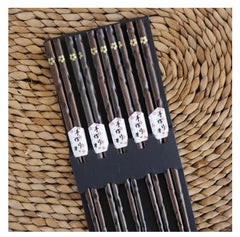5 Things You Didn't Know About Japanese Chopsticks
Introduction to Japanese Chopsticks
Hello everyone! Today we’re going to talk about Japanese chopsticks, what makes them special and some unique differences between them and other types of chopsticks like Chinese, Korean, etc. Without further ado, here are 5 things you didn’t know about Japanese Chopsticks:
-
Japanese chopsticks are pointed at one end
In addition to different materials, chopsticks also come in many different styles. Unlike Chinese chopsticks, which are the most commonly seen, Japanese chopsticks tend to be pointed at the ends. The Chinese chopsticks and ones we see most commonly are flat, or more “rectangular”. Here’s a side by side to compare the two different types of ends:

-
How to Say Chopsticks in Japanese?
In Japan, chopsticks are called 箸, or hashi. It’s not entirely clear the etymology of hashi, but historians believe that it came from the words kuchibashi (bird’s beak) and hashi (which also means mouth). The theory is that chopsticks resembled bird beaks when spread apart.

Historically, chopsticks in Japan were 8 inches in length for men, and 7 inches for women. In 1878, Japan invented the now universal disposable set of chopsticks made of bamboo and wood chopsticks. While these disposable sets are the most common nowadays, people have dined with chopsticks made of jade, ivory, brass, and for the wealthy, silver. It was believed that silver would react with any poisons and serve as a precautionary defense.
-
How do you use chopsticks Japanese style?
Chopsticks in Japanese style are not unlike other chopsticks. In fact, because Japanese chopsticks tend to be a bit more pointed, it’s likely that they have a bit more precision and once mastered, it can be easier to pick up smaller items. Similarly, some users may find it easier to learn how to eat rice with chopsticks using Japanese chopsticks due to the pointed ends.
Beyond that, using Japanese chopsticks follows the same principles as using other chopsticks:
- Start with holding one chopstick exactly as you would hold a pencil—supporting it with your thumb, index finger, and middle finger. Don't overthink it.
- Next, slide the second chopstick under your thumb, and over your ring finger and pinky finger. Use your ring finger and pinky finger to “wedge” against and hold the second chopstick in place. Pro tip: the second chopstick (bottom one) does not move. You want this chopstick to stay as stationary as possible
- Move the top chopstick using your thumb, index finger and middle finger. Gently “flex” these three fingers to move the chopstick up and down. The bottom chopstick remains stationary and acts as the contact point for the chopstick tips
-
Chopsticks symbolize "bridge" in Japanese culture

In ancient history, chopsticks in Japanese culture symbolized a “bridge” between humans and the divine. It was believed that a pair of chopsticks represented the mortal and immortal dining together, sharing food. Unlike their Chinese counterparts with the same thickness throughout, Japanese chopsticks are tapered.
-
Are Chopsticks from China or Japan?
Technically, the very first origins of chopsticks are of Chinese descent. According to experts’ best guess, the earliest versions were probably twigs used as tools to retrieve food from hot pots. Then, throughout history and during times of turmoil when resources became scarce, some chefs began to conserve fuel by making food into smaller pieces so it would cook quicker. This new method of cooking made it unnecessary to have knives at the dinner table—a practice that also coincided with the peaceful teachings of Confucius, as expressed in one of his numerous quotable quotations: "The honorable and upright man keeps well away from both the slaughterhouse and the kitchen. And he allows no knives on his table."

5 Examples of Authentic Japanese Chopsticks
-
Natural Wood Japanese Chopsticks
-
Cherry Wood Japanese Chopsticks
-
Red Flower Japanese Chopsticks
-
Dark Wood Japanese Chopsticks
-
Dragonfly Japanese Chopsticks
Resources for Japanese Chopsticks
If you’re looking for more resources on Japanese chopsticks, read our other articles and this additional links for more information:
Recap
Japanese chopsticks are not all that different from their other Asian counterparts. Remember the 5 things that make them unique:- Japanese chopsticks tend to be more pointed at the ends
- Chopsticks in Japanese are called hashi and represented by the character " 箸"
- You use Japanese chopsticks just like you would any other chopsticks
- Japanese chopsticks have been believed to symbolize the "bridge" between human and deities
- Technically, the very first chopsticks are believed to be from ancient China




